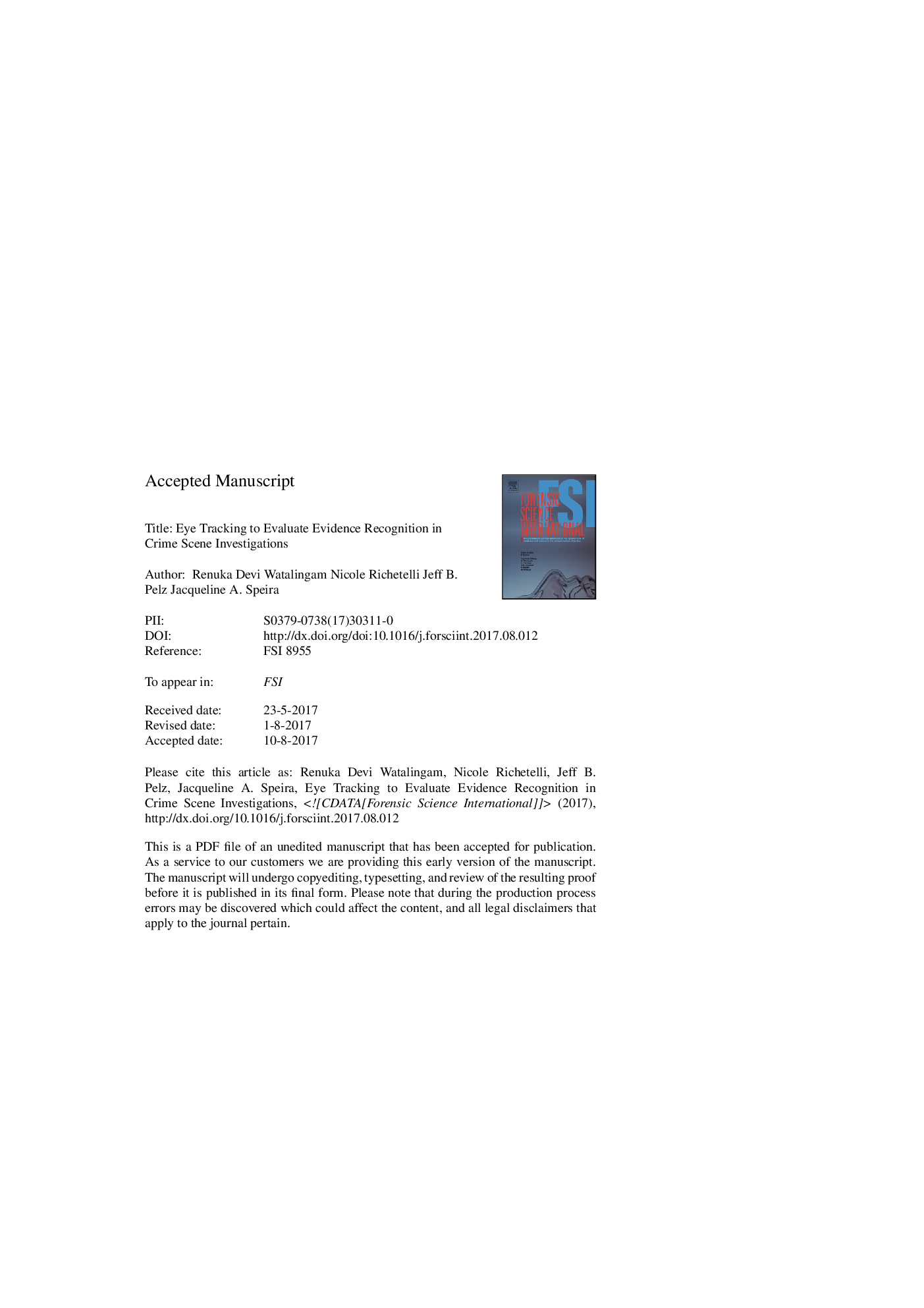| کد مقاله | کد نشریه | سال انتشار | مقاله انگلیسی | نسخه تمام متن |
|---|---|---|---|---|
| 4760234 | 1421970 | 2017 | 61 صفحه PDF | دانلود رایگان |
عنوان انگلیسی مقاله ISI
Eye tracking to evaluate evidence recognition in crime scene investigations
ترجمه فارسی عنوان
ردیابی چشم برای به دست آوردن شناخت شواهد در تحقیقات جغرافیایی
دانلود مقاله + سفارش ترجمه
دانلود مقاله ISI انگلیسی
رایگان برای ایرانیان
کلمات کلیدی
بازرسی صحنه جرم، تجربه و تخصص، ردیابی چشم، اهمیت شواهد، تفسیر شواهد،
موضوعات مرتبط
مهندسی و علوم پایه
شیمی
شیمی آنالیزی یا شیمی تجزیه
چکیده انگلیسی
Crime scene analysts are the core of criminal investigations; decisions made at the scene greatly affect the speed of analysis and the quality of conclusions, thereby directly impacting the successful resolution of a case. If an examiner fails to recognize the pertinence of an item on scene, the analyst's theory regarding the crime will be limited. Conversely, unselective evidence collection will most likely include irrelevant material, thus increasing a forensic laboratory's backlog and potentially sending the investigation into an unproductive and costly direction. Therefore, it is critical that analysts recognize and properly evaluate forensic evidence that can assess the relative support of differing hypotheses related to event reconstruction. With this in mind, the aim of this study was to determine if quantitative eye tracking data and qualitative reconstruction accuracy could be used to distinguish investigator expertise. In order to assess this, 32 participants were successfully recruited and categorized as experts or trained novices based on their practical experiences and educational backgrounds. Each volunteer then processed a mock crime scene while wearing a mobile eye tracker, wherein visual fixations, durations, search patterns, and reconstruction accuracy were evaluated. The eye tracking data (dwell time and task percentage on areas of interest or AOIs) were compared using Earth Mover's Distance (EMD) and the Needleman-Wunsch (N-W) algorithm, revealing significant group differences for both search duration (EMD), as well as search sequence (N-W). More specifically, experts exhibited greater dissimilarity in search duration, but greater similarity in search sequences than their novice counterparts. In addition to the quantitative visual assessment of examiner variability, each participant's reconstruction skill was assessed using a 22-point binary scoring system, in which significant group differences were detected as a function of total reconstruction accuracy. This result, coupled with the fact that the study failed to detect a significant difference between the groups when evaluating the total time needed to complete the investigation, indicates that experts are more efficient and effective. Finally, the results presented here provide a basis for continued research in the use of eye trackers to assess expertise in complex and distributed environments, including suggestions for future work, and cautions regarding the degree to which visual attention can infer cognitive understanding.
ناشر
Database: Elsevier - ScienceDirect (ساینس دایرکت)
Journal: Forensic Science International - Volume 280, November 2017, Pages 64-80
Journal: Forensic Science International - Volume 280, November 2017, Pages 64-80
نویسندگان
Renuka Devi Watalingam, Nicole Richetelli, Jeff B. Pelz, Jacqueline A. Speir,
